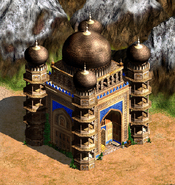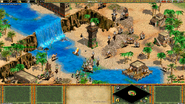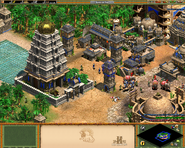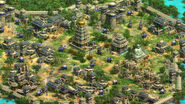No edit summary |
|||
| Line 170: | Line 170: | ||
* Except for [[Native Americans|Native American]] civilizations, the Indians are the only civilization in ''Age of Empires II'' that do not have access to units from the [[Knight]] line. Instead, they have the [[Imperial Camel Rider]]. |
* Except for [[Native Americans|Native American]] civilizations, the Indians are the only civilization in ''Age of Empires II'' that do not have access to units from the [[Knight]] line. Instead, they have the [[Imperial Camel Rider]]. |
||
** Historically, armies of various Indian states did field heavy cavalry, so the Knight line's absence and the prominence of Camel Riders in-game is historically inaccurate. |
** Historically, armies of various Indian states did field heavy cavalry, so the Knight line's absence and the prominence of Camel Riders in-game is historically inaccurate. |
||
| − | * One of the Indian AI player names, [[Akbar the Great|Akbar]], appears as the personality of the [[Indians (Age of Empires III)|Indians]] in [[Age of Empires III: The Asian Dynasties |
+ | * One of the Indian AI player names, [[Akbar the Great|Akbar]], appears as the personality of the [[Indians (Age of Empires III)|Indians]] in ''[[Age of Empires III: The Asian Dynasties]]''. |
=== Behind the scenes === |
=== Behind the scenes === |
||
Revision as of 15:19, 28 May 2020
| This article is about the civilization in Age of Empires II HD: The Forgotten. For the civilization in Age of Empires III, see Indians (Age of Empires III). |
| “ | Explore one of the most culturally vibrant and coveted regions in all of Asia! Wage war across the rich Indian subcontinent, the land of a thousand kingdoms and sultanates. Place vast armies under your command led by lethal camelry and durable Elephant Archers to terrify the invaders of your homeland. Prosperity is dearly won, yet your empire and deeds will stand the test of time. | ” |
| —Description[1] | ||
The Indians' civilization theme
The Indians are a South Asian civilization introduced in Age of Empires II HD: The Forgotten. They are based on Medieval and Mughal India situated on the Indian subcontinent. They focus Camel Riders and gunpowder units.
India is one of the world's most ancient civilizations that has existed for millennia, and Medieval India was also influenced by the introduction of Islam. Indian armies historically depended on elephants, so to depict this, they have the Elephant Archer as a unique unit. The northern part of Medieval India also introduced camels as a vital part of their military force, so they also have a unique upgrade to the Heavy Camel Rider, the Imperial Camel Rider, while their team bonus also provides Camel Riders with an attack bonus against buildings, and their own Camels also have more armor. India in the Middle Ages was a highly advanced civilization that learned the secrets of gunpowder from the Chinese and the Saracens, so to reflect this, their Hand Cannoneers are stronger than other civilizations' because of their Imperial unique technology, Shatagni, which increases their range by one. Indian kingdoms were very wealthy and their Castle Age unique technology, Sultans, reflects this by increasing all their gold income by 10%, including Relics and trade income. Fishing was an important part of the Indian economy, so their Fishermen work faster and carry more food. Thanks to their steady population growth over the centuries, Indian Villagers get cheaper as the civilization advances through the Ages.
Overview
The Indians are classified as a Camel Rider and gunpowder civilization. As such, they have excellent Camels with a unique upgrade, extra armor, an additional attack bonus against buildings, and all upgrades. They also have access to the Hussar, but no Knights at their disposal. Still, their cavalry branch is very prominent and strong. Their archers are also very good, most prominently their excellent Cavalry Archers and Hand Cannoneers with both getting all possible upgrades and the latter getting another +1 range from Shatagni, making the Hand Cannoneer one of the most prominent unit in Indian armies. Their infantry misses out on the final armor upgrade but get all unit upgrades. The siege weapons are underwhelming apart from the Bombard Cannon. Their navy is good, but the Fast Fire Ship and Shipwright are missing. Their Monks are average. Their defenses are weak, but their economy is good (only lacking Crop Rotation) and very beneficial for their playing style with faster gold income due to Sultans.
Campaign appearances
The Indians have a campaign devoted to their civilization: Prithviraj. They also appear in:
Battles of the Forgotten
- Bukhara
- Khorasan
Francisco de Almeida
- Estado da India
- Hindu Pirates
- Cannanore
- Kolathiri Raja
- Zamorin of Calicut
Gajah Mada
- The Pasunda Bubat Tragedy
- Indian Traders
Suryavarman I
- Challenging a Thalassocracy
- Chola Forces
Bayinnaung
- The Burmese Tigers
- Prome
Tamerlane
- Sultan of Hindustan
- Delhi
- Delhi Garrison
- Shah Tughlug
- Outlying Villages
- Outlying Villages
Characteristics
Unique units
 Elephant Archer: Mounted archer with a high amount of hit points
Elephant Archer: Mounted archer with a high amount of hit points Imperial Camel Rider: Upgrade of the Heavy Camel Rider, provides additional HP and attack
Imperial Camel Rider: Upgrade of the Heavy Camel Rider, provides additional HP and attack
Unique technologies
 Sultans: Increases the speed of all gold income by +10%.
Sultans: Increases the speed of all gold income by +10%. Shatagni: Gives Hand Cannoneers +1 range.
Shatagni: Gives Hand Cannoneers +1 range.
Civilization bonuses
- Fishermen work 10% faster and carry +15 food.
- Villagers are 10%/15%/20%/25% cheaper in the Dark/Feudal/Castle/Imperial Age.
- Camel Riders have +1 pierce armor.
Team bonus
- Camels have +6 attack against buildings.
Changelog
The Forgotten
- Villagers are 5%/10%/15%/20% cheaper in the Dark/Feudal/Castle/Imperial Age.
- Cannot research Guilds.
- Cannot research Ring Archer Armor.
- Imperial Camel Riders are in an armor class along with ships, and take bonus damage from anti-ship/anti-camel attacks.
- Elephant Archers cost 110F/80G.
- The upgrade to Elite Elephant Archer costs 1,200F/800G.
- Elephant Archers have 250 HP (350 for Elite).
- Elephant Archers have 4 pierce armor.
- Can train Arbalesters.
- Elephant Archers have -2 archer and 0 cavalry archer armor.
- Camel Riders have +1/+1 armor.
African Kingdoms
- Villagers are now 10%/15%/20%/25% cheaper in the Dark/Feudal/Castle/Imperial Age.
- Guilds added to the technology tree.
- Ring Archer Armor added to the technology tree.
- Initially can research Arrowslits. With patch 4.8, it was removed from the technology tree.
- The ship armor class is removed from the Imperial Camels, and they receive a new armor class, against which they gain an attack bonus of +9.
- Elephant Archers now cost 100F/80G.
- The upgrade to Elite Elephant Archer now costs 1,000F/800G.
- Elephant Archers now have 280 HP (330 for Elite).
- Elephant Archers now have 3 pierce armor.
Rise of the Rajas
- Feature a new and unique architecture style.
- With patch 5.5, the Arbalest has been removed from their technology tree.
- With patch 5.8, Elephant Archers have 0 archer and -2 cavalry archer armor.
- With patch 5.8, Camels have +1 pierce armor.
Definitive Edition
- With update 36906, Fishermen now work 10% faster instead of 15%.
- With update 37650, the anti-building bonus damage dealt by Camels is no longer partially negated by Masonry.
In-game dialogue language
In The Forgotten, the Indians used their namesake civilization's dialogue in Age of Empires III, which is anachronistic for the time frame as Villagers are using the English greeting "Hello!".
With the release of The African Kingdoms, Indian units speak in a different dialogue, using Hindi.
- Namaste. (नमस्ते.) - Greetings.
- Aadesh? (आदेश?) - Orders?
- Karunga/Karungi. (करूँगा/करुँगी.) - Will do.
- Main taiyar hoon. (मैं तैयार हूँ.) - I'm ready.
- Samajh gaya. (समझ गया.) - Understood.
- Turant. (तुरंत.) - Right away.
- Haan. (हाँ.) - Yes.
- Nirmaata (निर्माता.) - Builder.
- Shikaaree (शिकारी.) - Hunter.
- Lakadhara (लकड़हारा.) - Lumberjack.
- Chaara khojne vaala (चारा खोजने वाला.) - Forager.
- Kisaan (किसान.) - Farmer.
- Khanik (खनिक.) - Miner.
- Machhua (मछुआ.) - Fisherman.
- Mistree (मिस्त्री.) - Repairer.
- Hamla. (हमला.) - Attack.
- Aage bado! (आगे बढ़ो.) - Move forward!.
- Aakraman. (आक्रमण.) - Attack.
- Jee Shreemaan! (जी श्रीमान!) - Yes sir!
- Aapkee seva mein. (आपकी सेवा में.) - At your service.
- Main ja raha hoon. (मैं जा रहा हूँ.) - I'm going.
AI player names
When playing a random map game against the computer, the player may encounter any of the following Indian AI characters:
- Akbar (अकबर): Popularly known as Akbar I and later Akbar the Great, was the third Mughal emperor, who reigned from 1556 to 1605. He is the the personality of the Indians in Age of Empires III: The Asian Dynasties.
- Babur (بابر): Born Ẓahīr-ud-Dīn Muhammad, was an invader from Central Asia who, following a series of setbacks, finally succeeded in laying the base for the Mughal dynasty in the Indian subcontinent and became the first Mughal emperor.
- Bappa Rawal (बप्पा रावल): A semi-legendary ruler of the Mewar region in Rajasthan, India. The bardic chronicles describe him as a member of the Guhila clan of Rajputs, and some of these describe as the founder of his dynasty. Several historians have identified him with Kalabhoja, a ruler of the Mewar branch of the Guhilas.
- Chandragupta II: also known by his title Vikramaditya, was one of the most powerful emperors of the Gupta Empire in northern India.
- Humayun (हुमायूं): The second emperor of the Mughal Empire, who ruled over territory in what is now Afghanistan, Pakistan, and parts of northern India from 1531–1540 and again from 1555–1556. He is the father of Akbar.
- Iltutmish (इल्तुतमिश): The third ruler of the Delhi Sultanate, belonging to the Mamluk dynasty. Iltutmish consolidated the position of the sultanate in the Indian subcontinent.
- Jayachandra (जयचन्द): was an Indian king from the Gahadavala dynasty. He is also known as Jayachchandra (IAST: Jayaccandra) in inscriptions, and Jaichand in vernacular legends.
- Man Singh I (राजा मान सिंह): The Rajput Raja of Amber, a state later known as Jaipur in Rajputana. He was a trusted general of the Mughal emperor Akbar, who included him among the Navaratnas, or the nine gems of the royal court.
- Prithviraj Chauhan (भारतेश्वरः पृथ्वीराजः): was a king from the Chahamana (Chauhan) dynasty. He ruled Sapadalaksha, the traditional Chahamana territory, in present-day north-western India. He controlled much of the present-day Rajasthan, Haryana, and Delhi; and some parts of Punjab, Madhya Pradesh and Uttar Pradesh. His capital was located at Ajayameru (modern Ajmer), although the medieval folk legends describe him as the king of India's political centre Delhi to portray him as a representative of the pre-Islamic Indian power.
- Rajendra Chola (இராஜேந்திர சோழன்): Possibly refering to Rajendra Chola I or Rajendra I, was a Chola emperor of South India (Present day Tamil Nadu, Andhra pradesh, Kerala, Part of Karnataka and Telangana) who succeeded his father Rajaraja Chola I to the throne in 1014. During his reign, he extended the influence of the Chola empire to the banks of the river Ganga in North India and across the Indian ocean to the West and Southeast Asia, making the Chola Empire one of the most powerful maritime empires of India.
- Sultan Balban (सुल्तान बलबन): Ghiyas ud din Balban, the ninth sultan of the Mamluk dynasty reigned 1266–1287 dynasty of Delhi.
- Sultan Ala-ud-din Khilji (علاءالدین خلجی): The second and the most powerful ruler of the Khalji dynasty of Delhi Sultanate in the Indian subcontinent.
History
The history of the Indians already began in the Bronze Age when the first civilization, named the Indus or Harappan civilization, emerged in the fertile valley of the Indus in the fourth millennium BC. In this early period, the foundations of Indian culture were already made, for the caste system and the Vedas were introduced. The Vedas, a collection of the oldest Sanskrit texts, would influence the dozens of Indian political entities and religions throughout its history.
After the fall of the great Mauryan Empire (322 – 185 BC) India would not be under one rule again until the end of the medieval period. Instead, it was an ever shifting patchwork of political entities where some proved more successful than others:
The Gupta Empire (320-600 AD) was able to reunite the north of India through conquest and political marriage. Thanks to its strong rule, the empire enjoyed peace and prosperity, which in turn led to great cultural development: during this period literature, science, and architecture reached new heights and therefore it is often called the Golden Period. Internal factors, White Hunnic raids, and the disruption of Central Asian trade resulted ultimately in the fragmentation of the Gupta Empire.
Between the 8th and 10th century three great empires competed in an attempt to control the economically valuable Gangetic Plains. This long conflict, known as the Tripartite Struggle, often centered around the city of Kannauj. From the northwest the Gurjara-Pratihara Empire (550-1036) claimed it, from the northeast the Pala Empire (750-1174), and from the south the Rashtrakuta Empire (753-982). During the two centuries Kannauj changed hands regularly, but in the end no real victor emerged: the constant fighting made the kings neglect their internal politics and economy. Soon, feudatories in all three empires started to declare their independence.
From the 10th through the 13th centuries, one of the most successful dynasties in maintaining power were perhaps the Cholas in southern India. Not only did the Chola Empire rule the south at their peak; it was one of the few that broke the maritime boundaries of India by conquering overseas territories and establishing trade with Arabia and China. This maritime policy made the Cholas influential throughout East Asia. The Cholas were also renowned as patrons of the arts: the beauty of Chola sculptures was unseen, while King Rajaraja I constructed the Brihadeeswarar Temple, one of the greatest Hindu temples in the world.
This long-lasting rise and fall of political entities made India a melting pot of different cultures. Regardless of the dominating religious elements of ancient Hinduism, Buddhism and Jainism could often be found in one kingdom. However, during the medieval period, a fourth important religion came into play: Islam appeared in India as soon as the 7th century and would join the dance for power in the 12th century when political struggles in Central Asia forced Turks towards northern India. From these conquests emerged the Delhi Sultanate in 1206. At the height of their power, the sultans ruled over North and Central India while being one of the few entities to successfully resist the Mongol invasions. For five dynasties and 300 years, the Sultanate was seen as an important force, a symbol of prestige, and a source of unimaginable wealth. In 1526, it was conquered by a new Turkic power, the Mughals, signaling the end of the medieval period and uniting India again under one rule for the first time since the ancient Mauryan Empire.[2]
Trivia
- Prior to the release of Rise of the Rajas, the Indians shared the same architecture style as the Middle Eastern civilizations.
- The unique architecture style of the Indians featured in Rise of the Rajas is based on the architectural style of northwestern Rajput India, which has the intricate Hindu designs blending with Persian-influenced domes and arcs towards the Imperial Age. The Wonder is a South Indian Temple, while the Monasteries are pyramidal in shape similar to how it is found throughout North India.
- The bottom middle of Indians player's navigation bar shows the image of a lion in front of sun. The image is based from the flag of Mughal Empire.
- The Indians' civilization icon is based on Dharmachakra and Om.
- The Indians are both the first civilization to officially change their architecture design to a different style in a later update and are currently the only civilization in Age of Empires II to have a unique architecture set only used by a single civilization. Previously, the Italians' Mediterranean design was unique to only themselves prior to the release of African Kingdoms and the inclusion of the Portuguese.
- The new Indian Architecture was designed by modder "Tzontlimixtli", who worked with Forgotten Empires during the development of Rise of the Rajas.
- Prior to the release of Rise of the Rajas and during the release of The African Kingdoms and patch 4.4, an "Official Mod" of an earlier version of Tzontlimixli's Indian architecture was released on the steam workshop by Tzontlimixli and "Cysion" of Forgotten Empires. The Indians were also given duplicate versions of the Middle Eastern design, separate from the remaining civilizations that used it, for the sole purpose of using the modded version. The older version can still be found on the Steam Workshop.
- Except for Native American civilizations, the Indians are the only civilization in Age of Empires II that do not have access to units from the Knight line. Instead, they have the Imperial Camel Rider.
- Historically, armies of various Indian states did field heavy cavalry, so the Knight line's absence and the prominence of Camel Riders in-game is historically inaccurate.
- One of the Indian AI player names, Akbar, appears as the personality of the Indians in Age of Empires III: The Asian Dynasties.
Behind the scenes
During the development of The Conquerors, the region of India (along with Africa and pre-Columbian America) was considered to appear as the new architecture set; which theoretically means that at least two Indian-based civilizations can appear at the new game. But the plan was never materialized because the Ensemble Studios team preferred to add pre-Columbian America as the new architecture set.[3]
When the Forgotten Empires team were working on the Forgotten Empires mod (which eventually became The Forgotten expansion), they initially planned to add the Tibetans as one of the new civilizations. But the Tibetans were eventually replaced by the more military-oriented Indians.[4] Although it is never officially explained, it can be speculated that the Tibetans were removed because the official titles would face the risk of being banned in mainland China as the inclusion of the Tibetans in the game may be seen as a promotion of Tibetan independence by the Chinese government.
Gallery
Video overview
- Note: This video is outdated. It shows the Indians with the Middle Eastern architecture. They have their own unique architecture as of the release of Rise of the Rajas.
References
- ↑ https://www.forgottenempires.net/age-of-empires-ii-definitive-edition/civilizations/indians
- ↑ https://www.forgottenempires.net/age-of-empires-ii-definitive-edition/civilizations/indians
- ↑ http://aok.heavengames.com/gameinfo/conquerors-expansion
- ↑ https://www.forgottenempires.net/aof/the-story-so-far










